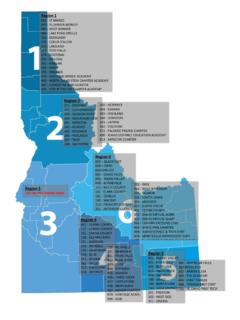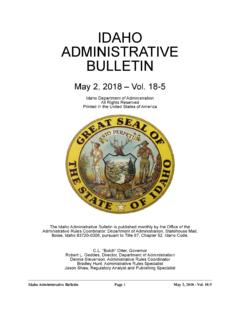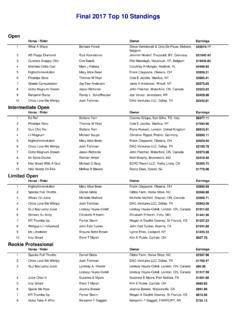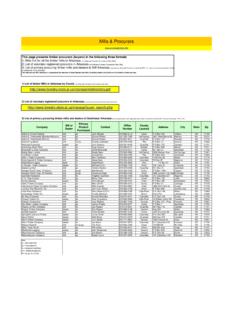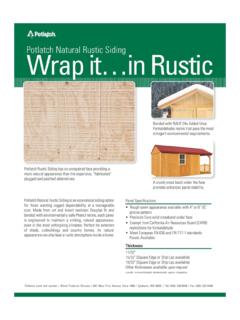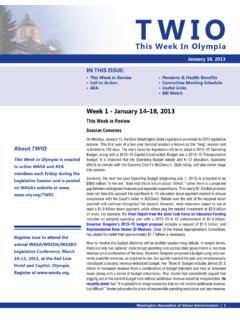Transcription of Lolo Creek Watershed - Clearwater County, Idaho
1 lolo Creek Watershed Total Maximum Daily Load Implementation Plan for Agriculture Developed for the Idaho Department of Environmental Quality Prepared by: Idaho Soil Conservation Commission In Cooperation with Clearwater Soil and Water Conservation District Date April 2011. TMDL Implementation Plan for Agriculture lolo Creek Watershed Introduction This report will serve as an addendum to the 1993 Agricultural Pollution Abatement Plan (APAP) lolo / Fords Creek final report, and will also serve as the lolo Creek Watershed Agricultural TMDL Implementation Plan.
2 The Idaho Department of Environmental Quality (IDEQ) is currently writing the TMDL for the lolo Creek Sub basin, and it should be completed in 2010. The Idaho State Soil and Water Conservation Commission (SWC) is responsible for preparing the lolo Creek Watershed TMDL Implementation Plan for grazing and agriculture. This implementation plan will focus on implementing Best Management Practices (BMPs) and will work toward restoring the designated beneficial uses to full support status. Purpose The lolo Creek TMDL Implementation Plan for Agriculture outlines an adaptive management approach for implementation of best management practices (BMPs) and resource management systems (RMS) on agricultural lands.
3 The purpose of this plan is to recommend BMPs that would improve or restore physical, chemical, and biological functions of lolo Creek Watershed . Goal The goal of this implementation plan is to assist in a comprehensive Watershed management plan focusing on agriculture and grazing improvements that compliment other resource improvements specified in the lolo Creek Tributaries Subbasin Assessment and TMDLs. The overall goal is to meet the TMDL load reductions for the listed pollutants and to restore and protect the designated beneficial uses of lolo Creek .
4 Objectives lolo Creek is listed in Section 2 (Waters that Support Beneficial Uses) on the 2008. Integrated 303(d) / 305(b) list as meeting full support status but Jim Brown Creek , a tributary to lolo Creek , is listed in Section 5 (Impaired Waters), as a water quality limited stream because of excessive nutrients, bacteria, sediment and temperature (Table 1). Musselshell Creek and Eldorado Creek are listed in Section 5 because of low biota and habitat ratings, based on the DEQ Bioassessment BURP Protocol. 2.
5 Table 1. 2008 303(d) impaired listed streams within lolo Creek Watershed (IDEQ, 2008). Stream Name Stream Description Listed Pollutants Jim Brown Creek Source to mouth Nutrients, Bacteria, ID17060306CL031_02 & Sediment, Temperature _03. Musselshell Creek Source to mouth Combined Biota/Habitat ID17060306CL032_02 & Bioassessments (DEQ - _03 BURP). Note: Eldorado Creek is also listed for combined biota/habitat bioassessments but will not be discussed further in this plan because of its location on USFS. This plan will focus implementation efforts on Best Management Practices (BMPs).
6 Designed to reduce nutrient, bacteria, and sediment contributions and to lower stream temperatures on lolo Creek and its tributaries on agriculture, pasture, hayland, and forestland. Emphasis will also be placed on BMP effectiveness evaluation and monitoring in terms of pollutant reduction and impacts on the existing beneficial uses of all the listed stream segments. A concerted effort will be made to coordinate all implementation projects with the many agencies and entities having resource management responsibilities within this Watershed .
7 A coordinated resource management plan between these agencies would greatly enhance the successful implementation of the lolo Creek Tributaries SBA/TMDLs. Background Project Setting The lolo Creek Watershed , located within the Clearwater River subbasin, consists of 156,786 acres and is located in the Columbia Plateau and Northern Rocky Mountains Geomorphic Provinces of north central Idaho (Figure 1). Bedrock predominantly consists of granitic rock of the Idaho Batholith on the east side, Columbia River Basalt on the west, and metamorphic rock on the southwest edge of the Watershed .
8 The portion of the Watershed developed in granitics exhibits a large amount of topographic relief and greatest channel density. Climate in the Watershed is characterized by cool moist winters and warm dry summers and varies with elevation. Rainfall patterns change markedly with elevation. The average annual precipitation ranges from 24 inches at Kamiah (elev. 1212 ft.) to 43. inches at Pierce (elev. 3188 ft.) to more than 70 inches at Hemlock Butte (elev. 5810. 3. ft.). At the higher elevations a greater proportion of the yearly total precipitation is received in the form of snow during the winter season (Nov.)
9 March). The growing season also varies in the Watershed based on climatic data from three nearby stations (Orofino, Kooskia, and Nez Perce). The average consecutive frost free period, above 32 degrees, ranges from 158 days at the lowest elevation, to 118 days on the upland prairies (CSWCD 1993). Soils within the lolo Creek Watershed are located on several different landforms with a mixture of parent materials. There are alluvial soils located on stream terraces and in basins. Soils on plateaus and uplands are formed in residuum and loess with ash mantle in areas.
10 Steep canyon sides with occasional gently sloping benches have soils formed in colluviums, residuum, and slope alluvium with an addition of loess and an ash mantle in areas. Foothills and mountainsides have soils formed in colluviums, residuum, and slope alluvium generally from granite or basalt. They have ash mantles of varying thickness. Vegetation consists primarily of conifer forest. The steep south-facing slopes on the North side of the canyon support ponderosa pine woodland interspersed with rocky, grassy openings, and sparsely vegetated cliffs and rock outcrops.
